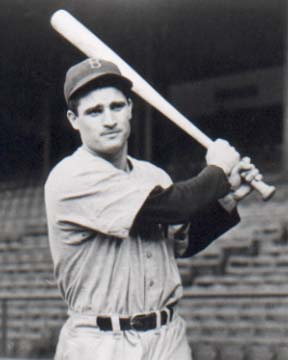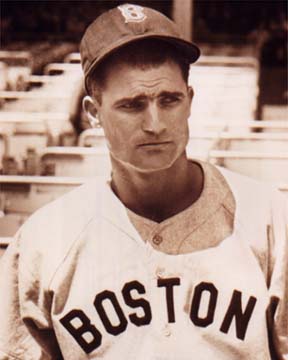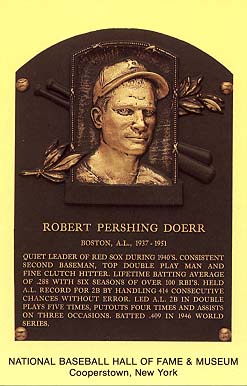

 |
|
|
 |
|
|
ROBERT PERSHING DOERR, born in April 1918 while GENERAL JOHN JOSEPH PERSHING was commanding the American Expeditionary Force in France, was a high school student in Los Angeles when a tremor toppled a telephone pole. In falling, it brushed ODIE BRANNON, the second baseman for the Hollywood Stars of the Pacific Coast League.
Brannon escaped serious injury, but played thereafter as though he was expecting another pole to descend upon him momentarily. A replacement was tried. He was no improvement. In desperation, Manager OSCAR VITT turned to his employer. "The kid who can do the job for us is that Bobby Doerr," he suggested. "Why don't we sign him now ?"
The proposition was laid before Bobby's father, Harold. The elder Doerr had coached the American Legion team on which Bobby had starred along with future major leaguers MICKEY OWEN and STEVE MESNER. The senior Doerr already had a son in the professional ranks, but objected to Bobby following suit. At 16, contended the head of the household, Bobby was entirely too young.
Vitt would not accept the verdict. He persisted until the elder Doerr relented. He approved on one condition: that Bobby receive a guaranteed two-year contract at $ 200 a month. It proved to be a landmark bargain for Vitt and all of baseball.
Within three years, Bobby Doerr was a .342 hitter for San Diego and was leading the Pacific Coast League in base hits with 238. He also was part of a dazzling double-play combination, teaming with GEORGE MYATT, four years his senior. Glowing reports of the youngster's achievements filtered eastward and excited the curiousity of major league executives.
Among those interested parties was the general manager of the Boston Red Sox. EDDIE COLLINS had been a crackerjack second baseman for more than twenty years, and if anyone was qualified to pass judgment on an infielder, that man was Collins. A personal inspection tour was the only way to satisfy his curiousity.
Eddie arrived in San Diego, the new home of the Hollywood franchise, and watched both Myatt and Doerr. He liked Myatt, but he loved Doerr, despite Bobby's erratic fielding in his first game. Collins attributed the defensive lapses to nervousness brought on by the awareness that Bobby was under scrutiny. Eddie remained in California for several more days and when he departed, his club owned the rights to Bobby Doerr.
Bushy-browed Bobby joined the Red Sox in 1937 and impressed manager JOE CRONIN as much as he had Collins. From his shortstop position, Cronin brought Doerr along slowly. The kid displayed a remarkable aptitude until halted by injury. He was beaned in an exhibition game and saw only limited action that season. Two years later, however, he was a .318 hitter and, in 1940, rapped 22 homers and drove in 105 runs.
Bobby remained a keystone kingpin until 1951. In 1944, he was named the American League Player of the Year by THE SPORTING NEWS. He was voted to the All-Star team eight times and, in 1943, sparked the American League to triumph at Philadelphia with a three-run homer off MORT COOPER. He appeared in one World Series, batting .409 in the Sox' seven-game loss to the 1946 Cardinals.
The 180-pound Californian established a league mark in 1948 by handling 414 consecutive chances flawlessly and led the league second basemen five times in double plays.
Had it not been for Doerr, a .288 lifetime hitter, BOB FELLER would have hurled five no-hitters rather than three. On May 25, 1939, and again on July 31, 1946, Bobby played the spoiler role with second-inning singles against the Cleveland fireballer. Doerr belittled the 1939 safety, maintaining, "I hit the ball off my ear and broke the bat."
Modesty was Doerr's hallmark. His steadiness precluded a flair that attracted more attention to players less generously endowed. In the dugouts, however, both friend and foe knew him for what he was. When JOE McCARTHY managed the Red Sox he commented, "I thought while managing the Yankees that JOE GORDON was as valuable a second baseman and as fine a team man as I ever saw. But I couldn't pick him over Doerr after what Bobby has shown me."
BUCKY HARRIS, a brilliant second baseman during his playing days with Washington, echoed McCarthy's sentiments. He placed Doerr "in a class by himself" and added, "It will be a long time before you see his equal. You take him for granted now. You won't realize his greatness until after he's through and somebody else is trying to play second base."
In 1946, when the Red sox won their first pennant since 1918, BABE RUTH showered additional praise on the second sacker. "Doerr, and not TED WILLIAMS, is the No. 1 player on the team," stated the Bambino. "He rates the Most Valuable Player in the American League." The MVP went to Williams.
During much of Bobby's career, a debate flourished about the relative merits of himself and JOE GORDON of the Yankees. Neither principal could be drawn into the argument. Invariably, they heaped praise on one another and visited the other's home for dinner when in the rival city. The issue never was settled satisfactorily or conclusively, though Doerr compiled better batting and fielding statistics.
Mild-mannered and with his emotions well concealed, Doerr spent 15 years in the majors without being ejected from a game. One of the few times he showed a flash of temper occurred in 1948. After TED WILLIAMS and VERN STEPHENS tagged JOE PAGE for consecutive home runs, the Yankees lefthander fired the next pitch at Bobby's head. "Knocking me down for something somebody else does, that's what gets me," he said with a touch of heat.
BOBBY DOERR collected his 2000th hit in July 1951. Three months later, hampered by chronic back problems, he called it quits and retired to his farm in the wilds of Oregon.
TRANSCRIBED FROM
BASEBALL'S HALL OF FAME - COOPERSTOWN - WHERE THE LEGENDS LIVE FOREVER
WRITTEN BY
LOWELL REIDENBAUGH
EDITED BY
JOE HOPPEL
Revised and updated by the editors of THE SPORTING NEWS
Published by GRAMERCY BOOKS, an imprint of
RANDOM HOUSE VALUE PUBLISHING, INC., 201 East 50th Street, New York, New York 10022
by arrangement with THE SPORTING NEWS, a division of TIMES MIRROR MAGAZINES, INC.




|
|
|
|